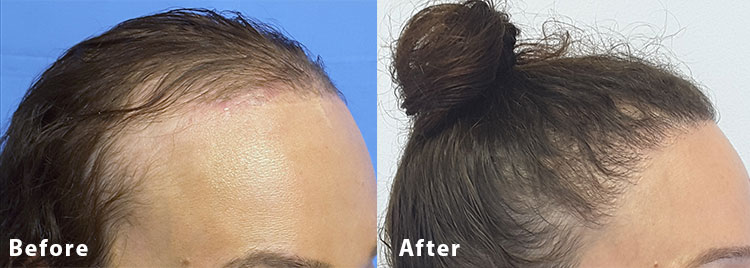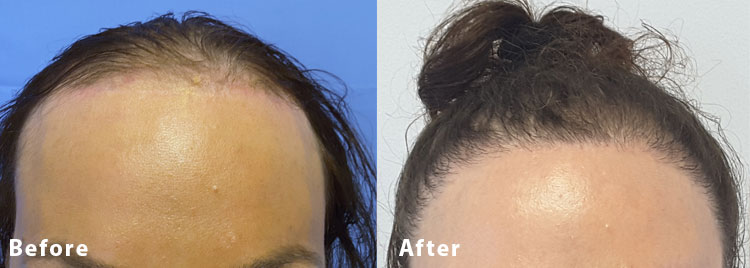
From personality to style to gender, hair plays a huge role in defining ourselves. That’s why growing hair reflective of how we feel inside and out is essential. However, sometimes we’re not born with the hair we feel displays our true self—and this is especially true for those transitioning.
Both male-to-female (MTF) and female-to-male (FTM) transgender individuals will seek hair restoration surgeons. The patient’s goal is to show off the hair that best correlates with their gender identity. At Limmer HTC, we proudly offer our services and expertise in conducting this precise procedure with the utmost care and compassion.
Though there are similarities between hair transplants for transgender and cisgender patients, don’t be fooled into thinking they’re the same thing. Whether you’re seeking a MTF scalp hair transplant or a FTM facial hair transplant, creating a natural look takes nuance, experience, and an understanding of the unique challenges for transgender patients.
Are Transgender Hair Transplants Different From Other Transplants?
Absolutely. Though there are similarities between hair restoration for transgender and cisgender individuals, the strategy behind creating a natural look varies drastically.
First off, natural male and female hair grows quite differently from each other. This applies to hairline, coverage, direction, shape and more. By trusting surgeons experienced in working with transitioning patients, you can rest assured that they understand these differences.
Also—in particular for MTF patients—it’s not just about combating androgenetic alopecia, or male-pattern baldness. It’s also about creating more feminine features and hairlines. Carrying out this process takes artistry and understanding about what makes male and female hairlines aesthetically different and appealing.
For FTM patients, the primary issue typically doesn’t involve current or potential balding. However, there are still subtle ways that surgeons can adjust the hairline to create a more masculine look.
Instead, most FTM patients are seeking a facial hair transplant. Sometimes, even after long-term hormone use, they don’t quite achieve the beard, mustache, or sideburns desired. By undergoing a facial hair transplant, they may achieve their ideal look. Our surgeons are experts at designing incredibly natural facial hair.
How Do Transgender Hair Transplants Work?
Previously, MTF hair restoration relied on a forehead reduction procedure where surgeons dissected a large flap of scalp and pulled the hairline down to minimize the forehead size—sort of like a reverse face lift. Thankfully, this is going out-of-style for more modern methods.
Not only did this old surgery leave behind a visible and sometimes large scar, it also failed to create a truly natural feminine or masculine hairline. Just as important, this procedure fails to address the progression of male pattern baldness as the person ages, which can leave the scars even more unsightly in the future.
Today, we prefer more advanced procedures that allow surgeons to tackle the needs that the forehead lowering process ignored.
So, how exactly does a modern transgender hair transplant work?
In certain ways, the hair restoration procedure itself is more or less the same for any patient whether or not they’re transitioning.
Hair follicles are extracted from a donor area—usually located at the back of the head— using either the follicular unit extraction (FUE) or the follicular unit transplantation (FUT) method. Then, each follicle is inserted into 100’s or even 1000’s of small incisions where the new hair is to be implanted.
However, once the grafts are ready for placement, though the technique behind placing donor hair into the recipient areas is also similar, the artistry is what matters. So much about this process involves the expertise behind turning a more masculine hairline feminine and vice versa. The surgeon must carefully take each graft and insert it strategically in place allowing the new hairline to take shape.
Once the procedure is complete, the patient can go home and rest. Though they’ll likely be sore for a few days with some swelling, recovery is generally mild. Occasionally, people even go back to work the next day. Usually within a week, most patients feel fully recovered. Within two weeks, patients can go back to all normal activities. You are able to wear a wig within a few days after surgery to hide the healing process. For facial transplants, the recovery is more difficult to hide, but the signs fade within 1-2 weeks.
After approximately 3–6 months, the newly grafted hair will begin to grow.
The hairline shape might be something most people take for granted, but those transitioning know the importance behind those often subtle, gender-defining details and so do great hair transplant surgeons.
In addition, if you’ve previously undergone a hairline lowering surgery—or any other hair transplant—and are unhappy with the results, we’d love to see you. Transplants can be used to cover up surgical scars in or along the hairline. Likely with one procedure, our team can finally provide you with an incredible look.

Why Trust Limmer HTC for a Transgender Hair Transplant?
It’s essential to choose the right specialist to carry out this complex procedure. Both MTF and FTM hair transplants pose unique challenges that differ from traditional hair transplant surgeries. That’s why you need to choose more than an experienced surgical team—you need a team that understands the intricacies of transgender patients.
The Limmer HTC team has more than just exceptional hair transplant experience—they have compassion for those transitioning along with significant experience performing these particular surgeries. We use innovative, cutting-edge technology and current methods to ensure every patient receives their perfect head of hair.
You’re already undergoing a life-changing transformation. Don’t you deserve to have your hair transplant done with the utmost care, skill, and compassion? If you’d like to learn more about how Limmer HTC performs hair transplants for those transitioning—or you’re ready to schedule a consultation—call us anytime at (210) 496-9992, or set up an appointment online.







